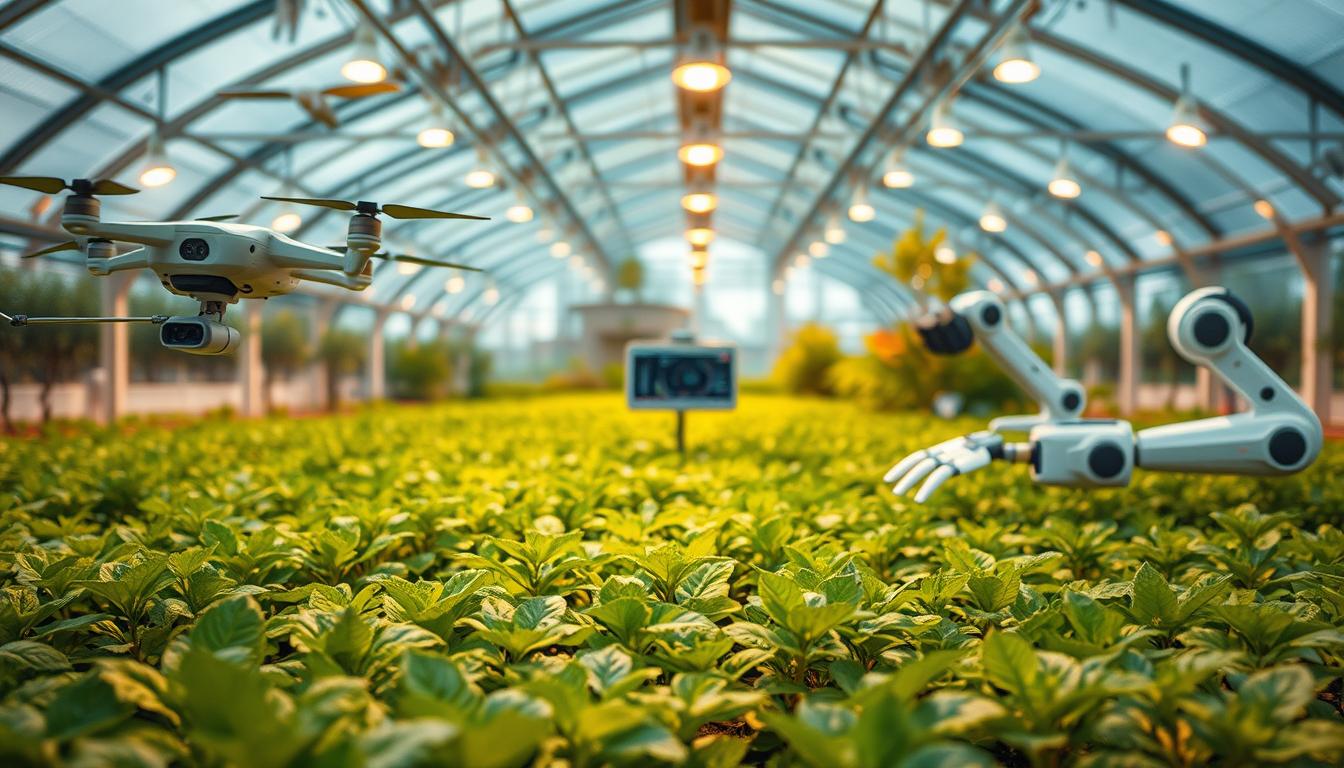Remember when gardening was just about dirt, seeds, and hope? Those days are changing fast. Digital tools are turning our gardens into connected spaces. Now, we have automated watering and soil sensors that text us when our plants need care.
Precision agriculture, once for big farms, now fits our home gardens. These tools save water, cut down on chemicals, and boost harvests. Even those with a few potted plants can join the green movement.
These technologies are easy to use. You don’t need to be a horticulture expert or a computer whiz. Apps can spot plant diseases from photos, and affordable sensors watch over your garden day and night. They work behind the scenes, helping both new and seasoned gardeners succeed with less effort.
Exploring modern gardening, you’ll see how these innovations can change your gardening game. Whether you have a lot of land or just a windowsill, there’s a digital solution for you. Your garden will thank you.
The Digital Revolution in Home Gardening
Technology and gardening have merged, changing how we care for our gardens. What used to need instinct, hard work, and family knowledge now gets a boost from sensors and data. This shift is not just about gardening; it’s also about how we connect with plants and nature.
From Manual Labor to Automated Cultivation
Gardening has changed a lot from its hard work beginnings. Early gardeners used simple tools like digging sticks and metal hoes. Now, we have smart systems that do tasks with little help from us.
Smart Gardening Technology has made daily tasks easier. Watering, once a daily task, is now done by systems that check soil moisture. Weeding, a constant fight, is tackled by robots that know the difference between plants and weeds.
These changes aren’t just for ease; they bring precision that humans can’t match. Automated systems give plants exactly what they need, when they need it. This cuts down waste and boosts results.
| Gardening Task | Traditional Method | Smart Technology Solution | Key Benefit |
|---|---|---|---|
| Watering | Manual hose or watering can | Soil moisture sensors with automated irrigation | Water conservation and optimal moisture levels |
| Soil Testing | Chemical test kits | Real-time digital soil analyzers | Continuous monitoring of soil health |
| Pest Management | Visual inspection and manual treatment | AI-powered detection cameras | Early intervention before damage occurs |
| Climate Control | Manual venting and covering | Automated greenhouse systems | Consistent optimal growing conditions |
The Changing Relationship Between Gardeners and Plants
As IoT gardening grows, our bond with plants changes. The smartphone is now as key as the trowel, changing how we garden.
Personal Connection in a Digital Garden
Some worry tech might make gardening less personal. But, digital tools can actually make us understand plants better.
Smart sensors show us things we might miss. Watching your plants grow on camera can make you appreciate nature more.
Balancing Technology with Traditional Practices
The best gardeners today use both old and new knowledge. They keep the wisdom of generations but also use tech.
Technology helps with routine tasks but can’t replace our intuition. A soil sensor might tell you moisture levels, but understanding what it means is still up to us.
Finding the right balance means using tech for routine tasks but keeping the hands-on parts of gardening. The digital revolution is about new ways to care for plants, not replacing us.
Smart Gardening Technology: Core Components and Systems
Every successful smart garden has a complex system of technology. It’s not just about simple tools anymore. Now, we use data and automation to create the best growing conditions. Knowing how these parts work together is key for anyone into smart gardening.
The Integrated Ecosystem of Modern Garden Tech
Smart gardening is more than just gadgets. It’s a complete system that works like nature. When the soil gets dry, sensors notice and the system waters without you.
This makes gardening a responsive, living system. Plants get what they need, when they need it. This leads to healthier plants and less waste. Precision farming is now for backyard gardens too.
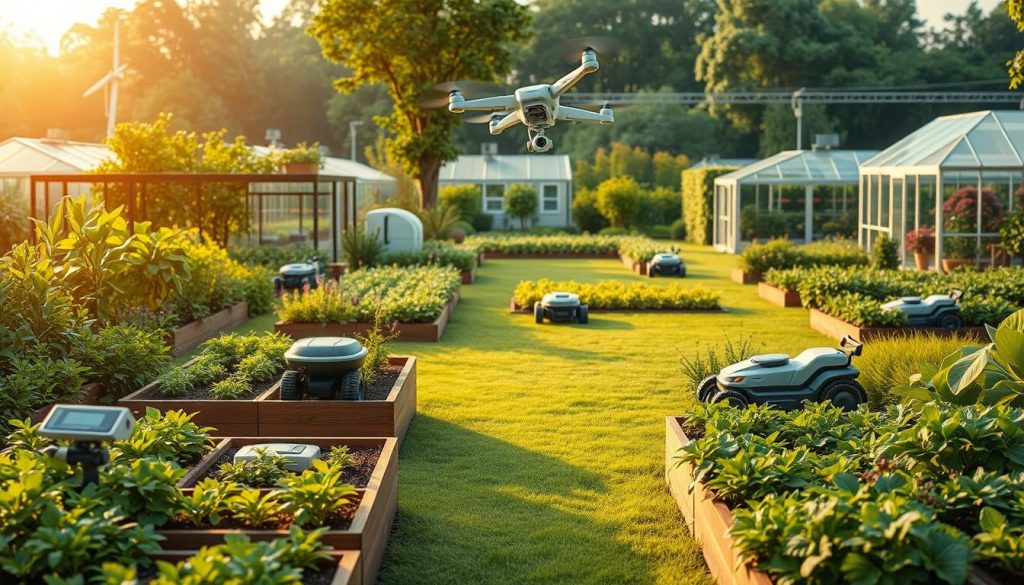
The parts of smart gardening systems are like the garden’s eyes, brain, and hands. Soil sensors check moisture, temperature probes watch the weather, and light sensors track the sun. These devices give us detailed info we can’t get by hand.
Controllers are the brain of the system, handling all the sensor data. They range from simple timers to complex hubs. Options include Raspberry Pi for tech lovers and ready-to-use systems like Rachio or Orbit B-hyve.
Actuators are the hands of the system, making changes based on controller commands. Examples include smart irrigation valves and motorized shade systems. They turn digital plans into real actions in the garden.
Software Solutions: Apps, Platforms, and Interfaces
The unseen part of IoT gardening is its software. Mobile apps make complex data easy to understand. They show garden conditions in a simple way.
Cloud platforms store data for long-term analysis. This helps gardeners see trends and adjust growing conditions. Many platforms also use weather forecasts to prepare for changes.
Premium gardening software uses machine learning for predictions. It learns about your garden and gets better over time. This helps predict watering needs and pest issues.
How These Systems Work Together
The magic of smart gardening is in how its parts talk to each other. Imagine a tomato plant on a hot day. Sensors notice the soil drying and the heat rising. The controller then waters the plant just right.
The gardener gets a notification about the watering. The system logs this data, building a profile of the plant’s needs. Over time, it might adjust watering based on the plant’s needs.
This precision was once for big farms but now home gardeners can use it too. It’s not just easy; it makes growing plants better and uses less water. Yields can go up by 50% compared to old methods.
Automated Irrigation Systems: The Foundation of Smart Gardens
Automated irrigation systems are key to smart gardens. They change how we water plants, making it easier and better for plants. These systems give the right amount of water to the roots, saving water and making plants healthier.
Today’s irrigation tech goes beyond simple timers. It uses sensors, weather data, and apps to water plants just right. This tech helps gardeners see how tech can make gardening easier, not harder.
Smart Sprinklers and Precision Watering
Smart sprinklers are a big step up from old ways of watering. They water exactly where needed, based on plant type and soil. This means less water waste and better plant care.
There are many smart irrigation systems out there. Brands like Rachio, Orbit B-hyve, and RainMachine are popular. They use Wi-Fi to connect to your home network.
These systems have apps that let you control watering from anywhere. You can get alerts and see how much water you’re using. Some even work with voice assistants, so you can water with just your voice.
| System | Key Features | Weather Integration | Price Range |
|---|---|---|---|
| Rachio | Zone-specific settings, seasonal adjustments | Local weather station data | $130-$280 |
| Orbit B-hyve | Catch cup integration, flow meter compatibility | WeatherSense technology | $100-$200 |
| RainMachine | Local operation capability, open API | NOAA weather forecasts | $120-$250 |
| Hunter Hydrawise | Professional-grade, multiple sensor inputs | Weather station networks | $150-$300 |
Installation and Setup Considerations
Some people worry about setting up smart irrigation. But most systems are easy to install yourself. It usually takes less than an hour if you have some DIY skills.
When picking a system, think about your garden’s needs. Count how many zones you need and if your Wi-Fi reaches the controller. Some systems need internet, while others work without it.
If you don’t have irrigation, there are battery-operated timers. They’re great for small gardens or apartments. They offer smart features without needing to install anything underground.
Weather-Responsive Watering Technology
Modern irrigation systems adjust watering based on the weather. They use local weather data to skip watering when it rains. This saves water and helps plants.
These systems also track temperature, humidity, and seasons. They adjust watering to match these changes. This means plants get the right amount of water, no matter the weather.
Some systems even have sensors or probes for super-accurate data. This makes watering even more precise, like an attentive gardener would do.
Water Conservation Impact and Efficiency Gains
Smart irrigation systems save a lot of water. The EPA says they can cut outdoor water use by 20-50%. This is because they water only when needed and in the right amount.
These systems also reduce waste by watering only where it’s needed. They adjust for different areas of your garden and change with the seasons. This means less water is wasted and plants get the right amount.
For many, the savings on water bills pay for the system in a year or two. But the real benefit is in healthier plants. They grow better because the soil stays moist, avoiding drought and overwatering problems.
Soil Intelligence: Sensors and Monitoring Solutions
Smart soil intelligence is changing gardening with advanced monitoring systems. These systems let gardeners see what’s happening underground. They make decisions based on real soil conditions, not just guesses.
Smart Soil Sensors and Their Functionality
Today’s soil sensors turn invisible underground data into useful information. These small devices check important factors that affect plant health. Most are wireless, battery-powered, and connect to phones or home systems.
These devices can measure:
- Moisture content at different soil depths
- Soil temperature changes
- Electrical conductivity (showing nutrient levels)
- Light exposure at soil level
- Soil compaction and structure
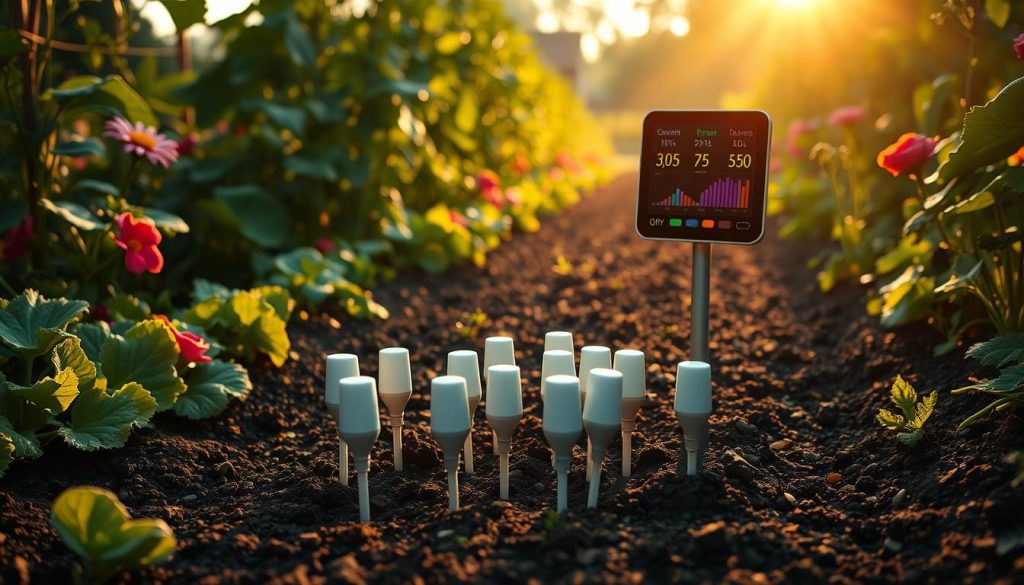
Real-Time Nutrient and Moisture Analysis
Soil sensors offer constant, real-time feedback. They watch your garden’s underground world all the time. This is different from traditional soil tests that only give snapshots.
Interpreting Soil Data for Better Growing
Understanding soil sensor data is key. Most systems turn raw data into easy-to-follow advice. For example, they might say “water needed” instead of just “15% moisture content.”
Many apps also show historical trends. This helps gardeners see how soil conditions affect plants over time. It builds a personalized growing guide for your garden.
Automated Fertilization Systems
Soil monitoring leads to automated fertilization. These systems use sensor data to add the right nutrients at the right time. They connect to water lines and add fertilizers during irrigation.
This approach avoids too much or too little fertilizer. It saves resources and keeps plants healthy. Some systems even adjust nutrient ratios based on plant growth stages.
pH Management Technologies
Soil pH is crucial for plant health. Modern pH sensors watch soil acidity levels closely. They alert gardeners when conditions are not right for certain plants.
Some systems can adjust pH levels automatically. They do this through irrigation lines, keeping conditions perfect for plants. This is great for acid-loving plants like blueberries or alkaline-preferring vegetables like asparagus.
Plant Health Monitoring and Management
Smart gardening tech now gives us deep insights into plant health. It lets us spot problems early and track growth. This leads to healthier plants and a more rewarding gardening experience for all.
Visual Monitoring Systems and Growth Tracking
Home gardeners can now track plant growth with smart cameras and sensors. These devices take daily photos of your plants. They show small changes in growth, leaf color, and overall health.
These systems also measure plant height, leaf spread, and stem thickness over time. This helps gardeners understand normal growth and spot any issues quickly.
Some systems use infrared or special lighting to show plant stress not seen by the eye. This early detection can save plants from decline.
AI-Powered Disease and Pest Detection
Artificial intelligence has changed how we detect problems in the garden. Machine learning algorithms can spot diseases, pests, and nutrient issues by analyzing leaves and growth.
These systems compare your plants to vast databases of known conditions. If a match is found, they suggest treatments or prevention.
The accuracy of AI detection grows as more gardeners share their knowledge. This way, even rare problems can be quickly found and fixed.
Mobile Applications for Plant Care
Gardening apps have made expert advice available to everyone. These apps offer identification, care schedules, and troubleshooting advice anytime.
- Plant identification apps that recognize species from photos
- Diagnostic tools that analyze plant symptoms
- Growth tracking calendars with customized care reminders
- Community forums for sharing experiences and solutions
- Integration with weather services for environmental context
User Experience and Accessibility
The best gardening apps are easy to use for all gardeners. Beginners get step-by-step help, while experts get detailed data and options.
Many apps now work with voice commands and screen readers. This makes gardening tech accessible to everyone, regardless of ability.
Data-Driven Plant Care Recommendations
Smart gardening systems use many data sources for personalized care. They consider your local climate, soil, plant needs, and sensor readings.
These systems help, not replace, a gardener’s intuition. They’re great for caring for unknown plants or unusual conditions.
As you use these systems, they learn about you. This creates a partnership between gardener and tech, blending traditional knowledge with digital precision.
Smart Greenhouse Automation for Year-Round Gardening
Modern greenhouse automation turns simple structures into smart growing spaces. They work with little human help. This lets gardeners grow plants all year, no matter the weather outside.
These systems use sensors, controllers, and smart devices. They create a self-regulating space. This keeps the best conditions for plants all year.
Climate Control Systems and Environmental Management
The core of greenhouse automation is its climate control systems. These systems watch and adjust temperature, humidity, and air flow. They make sure plants grow well.
Smart vents and fans work with heaters and coolers. When it’s cold outside, heaters kick in. When it’s too humid, dehumidifiers and fans turn on.
- Temperature regulation within 1-2 degree precision
- Humidity control systems that prevent fungal diseases
- CO₂ enrichment for accelerated plant growth
- Automated shade systems that respond to light intensity
Lighting Technologies for Optimal Plant Growth
Natural light changes with the seasons. But smart greenhouse lighting keeps plants lit all year. These systems can give plants the right light for each growth stage.
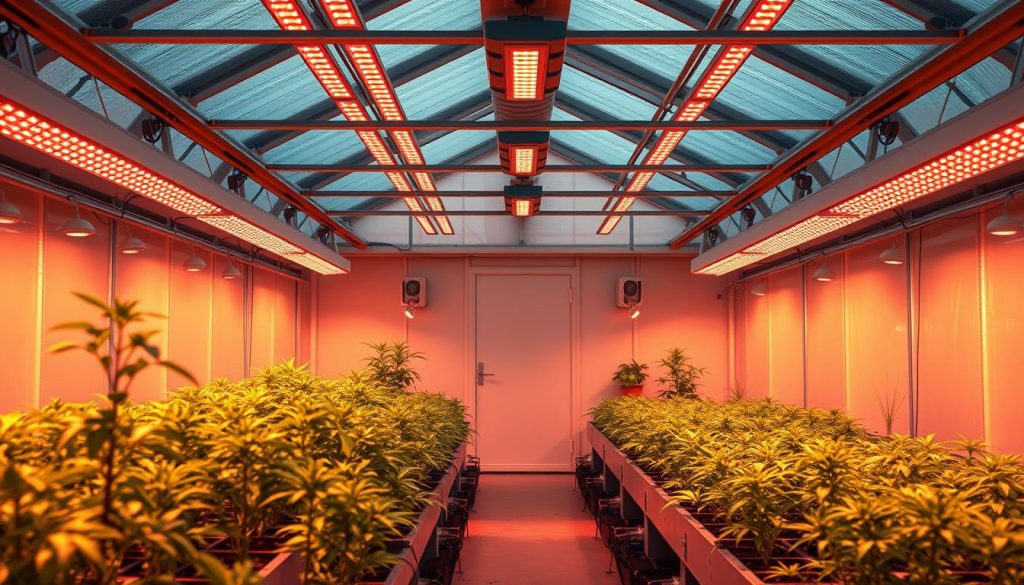
LED lighting has changed greenhouse lighting. It’s energy-saving and can be set to different light types. Gardeners can adjust it for growth, flowering, or fruiting.
Some systems even use UV and far-red light. This helps plants grow better and fight off diseases. LED lighting is precise, so plants get exactly what they need.
Day/Night Cycle Automation
Plants do best with regular light cycles. Automated lighting systems create these cycles. They can be set for different plants.
These systems slowly change light levels to mimic day and night. This helps plants grow healthy and strong. It leads to better yields.
Remote Monitoring and Management Capabilities
One of the best things about greenhouse automation is remote control. Gardeners can check and adjust their greenhouses from anywhere. This is thanks to smartphone apps.
These apps show real-time data and alert gardeners to any issues. Gardeners can change settings, see their plants, and get advice from AI. This makes gardening easy for busy people or those who travel a lot.
Even small greenhouses can use these technologies now. They’re becoming more affordable, making serious gardening possible for everyone.
Urban Farming Revolution: Vertical and Hydroponic Systems
The urban farming revolution has brought new ways to grow food in tight city spaces. With more people living in cities and less space, technology offers solutions. Now, balconies, windowsills, and small yards can become mini-farms, producing lots of fresh produce.
Space-Efficient Growing Technologies
Urban gardeners need to grow more in less space. Modern tech helps by growing plants up instead of out. This uses walls and clever designs to make the most of small spaces.
Vertical Farming Structures and Designs
Vertical farming has many forms, from DIY to commercial systems. Wall-mounted panels turn bare walls into growing spaces. They have built-in irrigation for plants.
Tower gardens stack plants around a central water system. They save space and can grow dozens of plants in a small area. Some towers even have moving LED lights for each plant.
A-frame gardens grow plants in a triangular shape. They fit lots of plants in a small area. This is great for leafy greens and herbs.
Small-Space Solutions for Urban Dwellers
Apartment dwellers use indoor growing systems. Window farms use recycled bottles for growing plants. They also have smart timers for watering.
Balcony gardens use modular systems that can change with space and crops. Smart sensors check conditions and alert when needed.
Tabletop micro-gardens are perfect for small spaces. They have lights, water, and climate control for growing plants anywhere.
Hydroponic and Aeroponic Innovations
Soil-free growing methods like hydroponics change urban farming. They use up to 90% less water than soil gardening. Plants grow faster in nutrient-rich water.
Countertop hydroponic gardens grow herbs and greens in kitchens. They connect to apps for monitoring and recipes.
Aeroponic systems suspend plants in air with misted roots. This method boosts growth and yields. Small aeroponic towers can grow lots of greens and even tomatoes.
Integration with Smart Home Ecosystems
Urban farming systems now connect with smart homes. Voice control lets people manage gardens with simple commands. “Alexa, water the lettuce” can do the job.
Automated systems control climate for plants. They adjust lighting, humidity, and temperature. They even adjust based on weather forecasts.
Smartphone apps manage urban farming. They monitor, schedule care, and offer advice. Apps also connect farmers for sharing knowledge and support.
IoT Gardening: Connected Plant Care Ecosystems
Gardening meets the Internet of Things, creating a new way of caring for plants. This digital leap turns gardening into a smart system. Now, gardens adapt to plants’ needs, thanks to data-driven choices.
The Internet of Growing Things
IoT gardening links garden devices through wireless networks. They share data and work together. Soil sensors talk to irrigation systems, and weather stations guide lighting controls. Your smartphone gets all the updates.
Soil sensors tell your garden when plants need water. If it’s going to rain, the system adjusts watering. This smart communication boosts your garden’s efficiency and productivity.
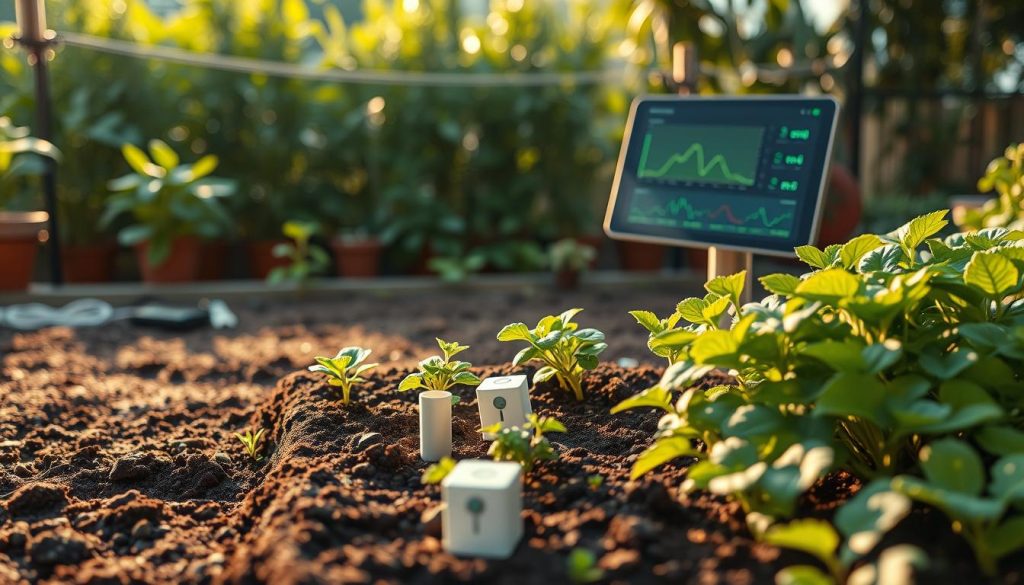
Voice-Controlled Garden Management
Smart gardens now listen to your voice commands. This hands-free gardening is great when your hands are full of soil.
Amazon Alexa and Google Home Integration
Voice assistants like Alexa and Google Home manage your garden. Just say “Hey Google, water the vegetable garden” to control systems. You get updates without touching a screen.
Custom Automation Routines
Smart gardening lets you create complex routines. You can set up “vacation mode” or “frost alert” routines. These routines make gardening easier and more efficient.
| Voice Assistant | Garden Control Capabilities | Information Retrieval | Automation Features |
|---|---|---|---|
| Amazon Alexa | Watering, lighting, ventilation | Moisture levels, temperature, plant status | Time-based routines, sensor-triggered actions |
| Google Home | Irrigation control, greenhouse management | Weather forecasts, growing conditions | Multi-step sequences, conditional triggers |
| Apple HomeKit | Water valve control, lighting scenes | System status, sensor readings | Location-based triggers, time of day automation |
Data Analytics for Optimizing Plant Growth
IoT gardening’s real strength is in data analysis. It collects and analyzes growing conditions over time. This creates a detailed history for each plant in your garden.
These systems spot patterns you can’t see. Maybe your basil grows better in the morning, or tomatoes need specific soil moisture. With enough data, your garden becomes self-optimizing.
Privacy and Security Considerations
Smart gardens raise security concerns. Your garden data might seem small, but it can be a risk. Connected systems can be entry points for hackers.
To keep your garden safe, use strong passwords and update firmware. Consider if each device needs internet access. Some gardeners prefer local networks for privacy and automation.
Overcoming Barriers to Smart Garden Adoption
As smart gardening tech grows, it’s key to tackle adoption barriers. The perks of precision agriculture in gardens are clear. Yet, many gardeners face obstacles to using these technologies. Understanding these challenges helps make smart gardening more accessible to all.
Cost Considerations and Budget-Friendly Options
For many, the cost of smart gardening tech is a big hurdle. A full system can cost hundreds or thousands. But, gardeners on a budget can start with smaller, expandable systems.
Starter kits with basic features are now available. DIY fans can also find plans online for making their own sensors and controllers cheaply.
While it may seem pricey at first, the long-term savings are worth it. Smart irrigation cuts water use by 30-50%. Precise nutrient monitoring also saves on fertilizers. These savings can pay off in a few seasons.
Simplifying Technology for All Gardeners
Another challenge is the tech learning curve. It’s tough for older gardeners or those who prefer to disconnect from tech. But, makers are making things easier with simpler interfaces and setup.
Voice-controlled systems and apps with clear dashboards are making gardening easier. These tools help gardeners manage their space without getting lost in tech.
Online forums, local clubs, and library workshops are helping gardeners learn about smart gardening. These resources offer a place for sharing experiences and tips.
Environmental Impact and Sustainability Concerns
Some gardeners worry about the environmental impact of smart gardening tech. They’re concerned about energy use and material sustainability. These are important issues to consider.
Energy Usage of Smart Garden Systems
Modern smart gardening systems aim to be energy-efficient. Many use solar power, cutting down on grid electricity. Low-power tech also reduces energy needs.
Even devices that need electricity often save more energy in the long run. For example, smart irrigation cuts down on water treatment energy.
Material Sustainability and Lifecycle Considerations
The electronic parts in smart gardening devices raise concerns about waste. But, some makers are designing products with recyclable materials and longer lifespans.
When buying smart garden tech, look for companies with recycling programs. Some sensors are even made with compostable casings.
By tackling these barriers, we can make smart gardening better for our environment and personal preferences. This way, we can enjoy our gardens more while caring for the planet.
The Future Garden: Where Technology and Nature Converge
Looking ahead, technology and nature are merging in gardens. Garden robots can now plant seeds, weed, and harvest crops with care. This lets gardeners enjoy the creative side of gardening.
AI systems are getting smarter, predicting what plants need with great accuracy. They learn from vast amounts of data worldwide. This helps plants grow well, even when the weather is unpredictable.
Urban farming is also getting a boost from new tech. Vertical farms in cities use smart systems to grow food efficiently. Future tech will likely make these farms even more productive and energy-saving.
Smart gardening networks are forming in communities. Neighbors share data online, creating maps of local growing conditions. This turns individual gardens into a shared knowledge base.
Smart gardening tech is changing how we see plants. It brings us closer to nature by showing us the hidden lives of plants. This connection is deep and meaningful.
The future garden will be both high-tech and nature-friendly. As these systems get easier to use, they promise to make gardening more sustainable and fun. They help us grow better plants and a better world.

